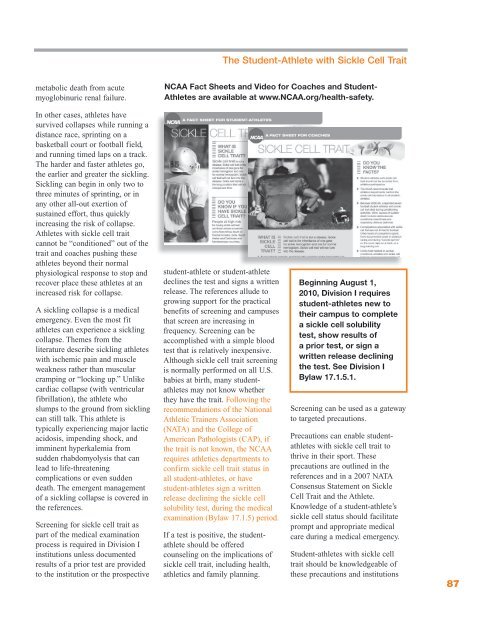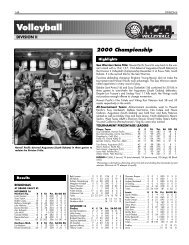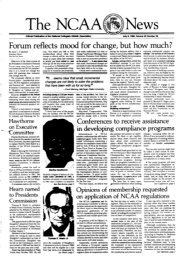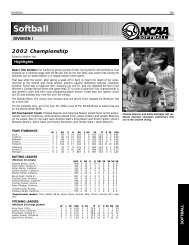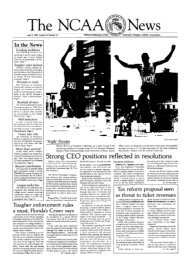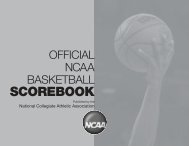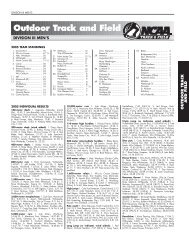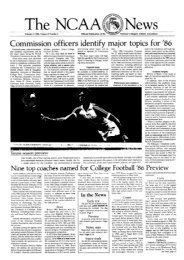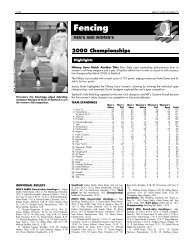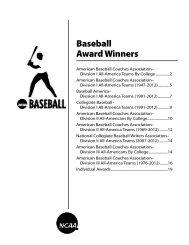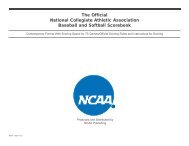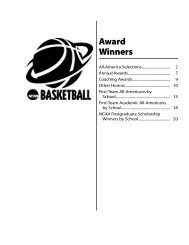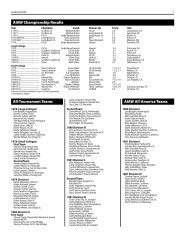Sports Medicine Handbook - NCAA
Sports Medicine Handbook - NCAA
Sports Medicine Handbook - NCAA
You also want an ePaper? Increase the reach of your titles
YUMPU automatically turns print PDFs into web optimized ePapers that Google loves.
metabolic death from acute<br />
myoglobinuric renal failure.<br />
In other cases, athletes have<br />
survived collapses while running a<br />
distance race, sprinting on a<br />
basketball court or football field,<br />
and running timed laps on a track.<br />
The harder and faster athletes go,<br />
the earlier and greater the sickling.<br />
Sickling can begin in only two to<br />
three minutes of sprinting, or in<br />
any other all-out exertion of<br />
sustained effort, thus quickly<br />
increasing the risk of collapse.<br />
Athletes with sickle cell trait<br />
cannot be “conditioned” out of the<br />
trait and coaches pushing these<br />
athletes beyond their normal<br />
physiological response to stop and<br />
recover place these athletes at an<br />
increased risk for collapse.<br />
A sickling collapse is a medical<br />
emergency. Even the most fit<br />
athletes can experience a sickling<br />
collapse. Themes from the<br />
literature describe sickling athletes<br />
with ischemic pain and muscle<br />
weakness rather than muscular<br />
cramping or “locking up.” Unlike<br />
cardiac collapse (with ventricular<br />
fibrillation), the athlete who<br />
slumps to the ground from sickling<br />
can still talk. This athlete is<br />
typically experiencing major lactic<br />
acidosis, impending shock, and<br />
imminent hyperkalemia from<br />
sudden rhabdomyolysis that can<br />
lead to life-threatening<br />
complications or even sudden<br />
death. The emergent management<br />
of a sickling collapse is covered in<br />
the references.<br />
Screening for sickle cell trait as<br />
part of the medical examination<br />
process is required in Division I<br />
institutions unless documented<br />
results of a prior test are provided<br />
to the institution or the prospective<br />
The Student-Athlete with Sickle Cell Trait<br />
<strong>NCAA</strong> Fact Sheets and Video for Coaches and Student-<br />
Athletes are available at www.<strong>NCAA</strong>.org/health-safety.<br />
student-athlete or student-athlete<br />
declines the test and signs a written<br />
release. The references allude to<br />
growing support for the practical<br />
benefits of screening and campuses<br />
that screen are increasing in<br />
frequency. Screening can be<br />
accomplished with a simple blood<br />
test that is relatively inexpensive.<br />
Although sickle cell trait screening<br />
is normally performed on all U.S.<br />
babies at birth, many studentathletes<br />
may not know whether<br />
they have the trait. Following the<br />
recommendations of the National<br />
Athletic Trainers Association<br />
(NATA) and the College of<br />
American Pathologists (CAP), if<br />
the trait is not known, the <strong>NCAA</strong><br />
requires athletics departments to<br />
confirm sickle cell trait status in<br />
all student-athletes, or have<br />
student-athletes sign a written<br />
release declining the sickle cell<br />
solubility test, during the medical<br />
examination (Bylaw 17.1.5) period.<br />
If a test is positive, the studentathlete<br />
should be offered<br />
counseling on the implications of<br />
sickle cell trait, including health,<br />
athletics and family planning.<br />
Beginning August 1,<br />
2010, Division I requires<br />
student-athletes new to<br />
their campus to complete<br />
a sickle cell solubility<br />
test, show results of<br />
a prior test, or sign a<br />
written release declining<br />
the test. See Division I<br />
Bylaw 17.1.5.1.<br />
Screening can be used as a gateway<br />
to targeted precautions.<br />
Precautions can enable studentathletes<br />
with sickle cell trait to<br />
thrive in their sport. These<br />
precautions are outlined in the<br />
references and in a 2007 NATA<br />
Consensus Statement on Sickle<br />
Cell Trait and the Athlete.<br />
Knowledge of a student-athlete’s<br />
sickle cell status should facilitate<br />
prompt and appropriate medical<br />
care during a medical emergency.<br />
Student-athletes with sickle cell<br />
trait should be knowledgeable of<br />
these precautions and institutions<br />
87


